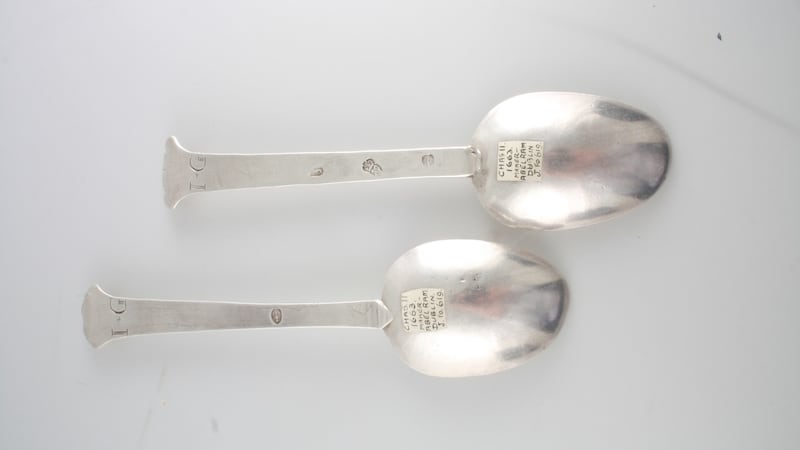As we lament the never-ending Luas works and complain about clamping, it’s hard for Dubliners to imagine what the city would have been like 350 years ago.
For a start it was a much smaller place; following an outbreak of plague the population had been reduced to less than 9,000 people, roughly similar to that of Skerries today.
There was just one bridge across the Liffey: a “living bridge” lined with houses and shops, with towers at either end. In the summer of 1649, Oliver Cromwell landed at Ringsend with the New Model Army – the start of a decade of fighting and slaughter. In May 1660, Charles II was proclaimed king.

Very few objects are still around to connect us to those tumultuous times – but a pair of silver spoons dating from 1663 will go on display at the Dublin Antique Fair in September.
“They’re the earliest hallmarked Irish silver that I’ve handled in over 50 years,” says silver expert Jimmy Weldon. “I did have a pair of spoons a few years ago which were from 1679, but you just don’t see Irish silver of that age and quality. These are in amazing condition and the marks are stunning. I’ve never had anything quite so thrilling as this.”
Trefid spoons are so named because their stem widens at the top and have two notches, forming a three-lobed shape suggestive of a deer’s hoof. This pair being a very early example, the ends turn upwards – later designs tend to be flatter. “They were made by Sir Abel Ram, one of the few silversmiths to be knighted,” Weldon says. “He later became lord mayor of Dublin and is buried in the family vault in Gorey.”
Hallmarked
The Ram family settled in Co Wexford after Thomas Ram, who came to Ireland as private chaplain to the Earl of Essex in 1599, was appointed bishop of Ferns in 1605.
Another relative, also called Abel, was to have a run-in with Jonathan Swift in 1728. His coachman collided with the author of Gulliver's Travels, knocking him down and prompting Swift to coin the satirical lines: "England's hope and Ireland's glory/Tipped in the ditch by the Ram of Gorey."
“I’ve only ever had one other piece by Ram,” says Jimmy Weldon. “Interestingly, he only got one of these spoons hallmarked – the other just has his maker’s mark – but they’re clearly a pair.
“They’re marked with a big early harp, which is quite different to the later ones; simpler and less defined, but very strong. They have a date letter – that particular date letter only occurs in 1663. Then you have the maker’s mark, which is AR conjoined, with a central device – a ram’s head – below it.”
As the 1660s progressed and the political situation remained stable, Dublin grew gradually more prosperous. In 1662, the Phoenix Park was laid out as a deer park; the first newspaper was produced in 1685, and the Royal Hospital for old soldiers was built in Kilmainham in the same year. A second bridge was built across the Liffey in 1670.
There were also some exotic entertainments on offer. In a specially constructed booth near the Custom House on Parliament Street, members of the public who were prepared to pay a hefty admission price could view a live elephant. The unfortunate animal died when the booth caught fire in June 1681.
There might, Weldon speculates, have been 30 to 40 silversmiths working in Dublin at this time, though few of the names are known to us nowadays. Abel Ram was one of the earliest; later came Thomas Bolton, Joseph Walker and David King, after whom King Street was named.
Survived
That this pair of spoons should have survived is, Weldon suggests, little short of miraculous. “They must have been in an attic somewhere for a couple of hundred years, to be in such good condition. They were known to exist at the beginning of documentation of Irish silver in 1912, by Sir Charles Jackson.
And we know that Kurt Ticher, a great collector of Irish silver, had them – or had sight of them – in 1950. I actually bought them while I was standing at the parade ring in Punchestown Races on the telephone.”
Can he put a value on the humble-looking spoons? “They’re worth at least €25,000,” he says. “Now, that’s a modest price. In good times they’d have been €75,000. But for me, it’s not the money at all. It’s the idea of handling something like that. They are so rare. These are the real deal.”
JW Weldon, 55 Clarendon Street, Dublin 2. See weldons.ie.
The Irish Antique Dealers’ Association Fair will take place in the RDS from September 21st to 24th, with a series of free guest lectures from some of the world’s leading experts in their fields.










